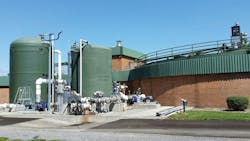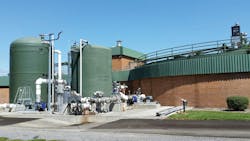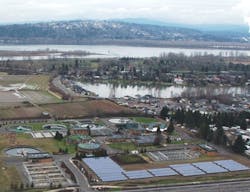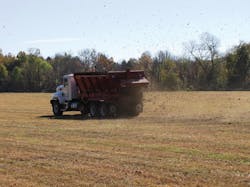As the saying goes, necessity is the mother of invention. With many cities today facing drought and dwindling water supplies, the search for new water resources has been booming. Rising electricity costs and an increasing number of government regulations mean that wastewater treatment facilities are looking for new ways to save and survive.
New technologies are taking wastewater biosolids and turning them into heat, energy, and soil, to start. These applications mean environmental and economic benefits for the cities that employ them at their wastewater treatment plants (WWTPs), plus, they are pretty cool - or hot - depending on the application we’re talking about. Here are some of the technologies and companies shaking up the industry.
Waste to Power
In 2015, the City of Gresham, Oregon’s wastewater treatment plant reached energy net-zero, producing more energy than it uses, and saving the city an estimated $500,000 in electricity costs. The 20-million-gallon-per-day, sludge-activated wastewater treatment plant, built in partnership with Veolia North America in 2005, serves a community of approximately 114,000, and comprises a beneficial use biosolids management program, industrial pretreatment program analyses, cogeneration operation, laboratory services and nine lift stations.
“This has been about a 10-year process to get where we are now,” said Alan Johnston, a senior engineer with the City of Gresham. “We set a goal of getting here in 2010, put together an energy management team to get there as soon as we could, and while we began generating power, we also replaced our aeration basin with bubble diffusers, put in more energy-efficient turbo blowers that minimized power consumption and maximized output at the same time.”
Since 2012, Gresham has operated as a receiving station for fats, oils and grease (FOG) from local restaurants and food service locations, doubling its biogas production.
Today, Gresham receives about 12,000 gallons of FOG, which its engineers then convert to biogas used to generate heat and electricity. The process is relatively simple. Wastewater first enters the treatment plant and flows through a screen, which removes any large objects. Small particles are simultaneously captured by a sedimentation tank. The sludge is then removed and fed into two 1-million-gallon anaerobic digesters that treat the solids and convert them to biogas. Co-generators on site then convert the biogas into heat and electricity, providing enough to heat the plant and produce about 10 percent more power than is needed to run the plant. “In 2015, we produced about 5.6 million kW/H of power, of which we used 5.3 million,” Johnston said.
Before the WWTP began accepting FOG, Johnston said, liquid organic waste was either dewatered and put into landfills or land-applied. “No one was recycling it the way we have been,” he said.
Extra power generated by the plant is used by the local energy utility, though Johnston said there is no system in place for the WWTP to generate funding from its excess energy yet.
“Hopefully in the future we will be able to receive some sort of reimbursement from Portland Gas and Electric, but for now we’ve designed the process to provide us with almost the exact amount of power we need.”
More Power to You!
Smaller WWTPs, like the one in Lancaster, Ohio, are getting in on the zero-energy trend, too. The plant, which processes approximately 5 MGD of sewage for the local community, is a pilot site for Q2Power’s energy generation system.
The Q2Power model M10 is a 10 kW (AC) distributed generation system that turns biogas waste into energy - as much as 250 kW/H. The engine/methane combustor system, instrumentation, controls, and associated gas and power lines have been installed in a 20-foot intermodal container at Lancaster. Up to 10 kW/H of power is currently being generated by the system, and in the next phase of installation, exhaust heat will be recycled and used to warm the plant’s bio-digester.
The model M10 works through an internal combustion process, creating a biogas steam, which is then ignited and used to generate power as it condenses. Unlike other treatment processes that ignite biogas and let the air out into the atmosphere, Q2P’s solution captures the heat from combustion, creating steam that condenses and then flows back into the system. But this is not the only initiative Lancaster, Ohio-based Q2P is working on.
Getting Dirty
Traditionally, most of the sludge that remains after wastewater processing is dumped or sent to a landfill. But escalating landfill costs and concern about future environmental impact are causing some to look elsewhere for a solution to managing wastewater residuals. Q2Power is just one company working to improve the environment by turning biosolids into compost and engineered soils. Through a partnership with ERTH Products LLC of metro Atlanta, Ga., these applications are turning what used to be considered trash into renewable - and economical - treasure.
According to the company’s website, “Q2P seeks to divert millions of tons of waste from landfills by repurposing it to create the foundation for economic growth.” Engineered soil could be used to improve the control of stormwater runoff, to conserve water during low-flow periods, and reduce runoff-associated pollution from construction sites. Its increased water-holding capacity makes the innovation worth noting, as it can replace commercially-used soils in areas prone to drought. The use of biosolids in this way also keeps landfills from filling up with sludge and other wastewater byproducts.
“Giving wastewater treatment facilities the power to become renewable resource recovery centers is a long term vision of ours, which we believe to be critical in building sustainable platforms to conserve water, nutrients and resources for our environment,” Wayne King Sr., chairman of ERTH and former president of the U.S. Composting Counsel, said in a statement.
Sundried and Ripened
In Fayetteville, Ark., the WWTP there is investing in other sustainable alternatives for managing wastewater treatment residuals, too. The process utilized by the Biosolids Management Site (BMS), which sits adjacent to the Paul R. Noland Water Resource Recovery Facility (WRRF), combines solar houses with a thermal heating unit to dry and create Class A biosolids that are then sold to farmers and residents to be reused as soil enhancements, creating additional revenue streams for the city.
“The property at the BMS is managed to provide nutrient uptake of phosphorus in the soil from past land application of biosolids,” operations manager Tim Luther said. “[There, we] process belt filter-pressed biosolids from the City of Fayetteville’s two WRRFs. The site is also permitted for land application of water treatment residuals (WTR).” Previously, these residuals were being landfilled by a local water treatment facility, but tests showed that the aluminum-rich material helped immobilize soluble soil phosphorus and would be beneficial to the BMS because of previous land application practices there.
“Instead of landfilling the WTR, the local water treatment facility pays the City of Fayetteville the previously paid landfill fees to beneficially reuse the material,” Luther said. “The site is also permitted for the land application of treated wastewater effluent used to irrigate the site hay that is harvested and sold to local farmers and residents and to incorporate the WTR into the soil.”
The annual average revenue generated by Fayetteville’s BMS from the sale of hay, fertilizer, and land application of water treatment residuals for the past three years was $277,306. Additionally, the hay and fertilizer are resources that residents need. Luther said annual requests for these resources at times is triple what is produced on-site.
“The City has always prided itself on being environmentally responsible,” Fayetteville Utilities Director Tim Nyander said. The City’s administration, he pointed out, strongly advocates compliance with environmental, health and public safety regulations, as well as being a good steward of natural resources. “Economically, the City of Fayetteville is constantly improving its methods to become the leader in sustainability,” he said. “The reuse of the City’s residuals is an environmentally responsible and beneficial use, and the sale of fertilizer and hay assists in our utility’s goal: The maximum amount of service at the lowest possible cost.”
The Time is Now
As resources begin to dwindle, the time for wastewater treatment plants to innovate is now. New technologies and partnerships are being developed every day, but government regulations are also becoming more stringent.
Both the EPA and the Water Environment Research Foundation support innovation through programs that bring leaders in the field together to work toward solutions. EPA’s Water Technology Innovation Blueprint and WERF’s Leader Innovation Forum for Technology (LIFT), in partnership with the Water Environment Federation (WEF), focus on technologies that could transform the industry. Both programs provide funding for research projects and testing programs for new ideas, with support to ensure that projects remain in compliance with current federal legislation.
About the Author: Alanna Maya is the assistant editor for WaterWorld and Industrial WaterWorld magazines. Email her at [email protected].
Partnerships on the Horizon
Municipalities across the country are working actively to reward innovation in the wastewater sector, providing grants and scholarships to plants and operators who can do things differently than they have always been done. The Massachusetts Clean Energy Center, for example, provides up to $150,000 in funding for the “piloting of innovative technologies at publicly-owned wastewater treatment facilities” in the areas of energy efficiency, water reuse, or nutrient removal.
The New York State Energy Research and Development Authority (NYSERDA) is a public benefit corporation focused on research and development of energy-efficiency and environmental programs in New York. The organization provides grants to municipal facilities and public water system owner-operators for projects that develop innovative and energy-efficient technologies. Past projects focused on the areas of wastewater treatment processing, wastewater collection, and biosolids management.
These are just some of hundreds of funding programs available to develop innovative wastewater treatment technologies.
More WaterWorld Current Issue Articles
More WaterWorld Archives Issue Articles
About the Author

Alanna Maya
Chief Editor
Alanna Maya is a San Diego State University graduate with more than 15 years of experience writing and editing for national publications. She was Chief Editor for WaterWorld magazine, overseeing editorial, web and video content for the flagship publication of Endeavor's Water Group. In addition, she was responsible for Stormwater magazine and the StormCon conference.






